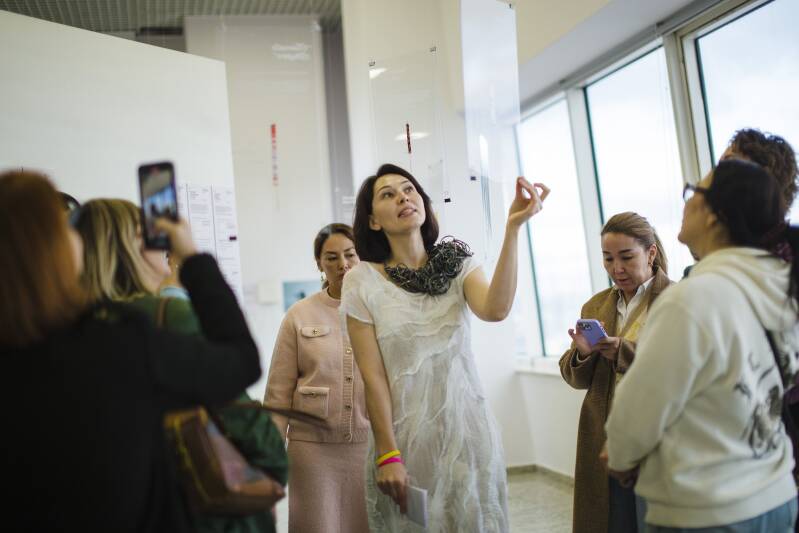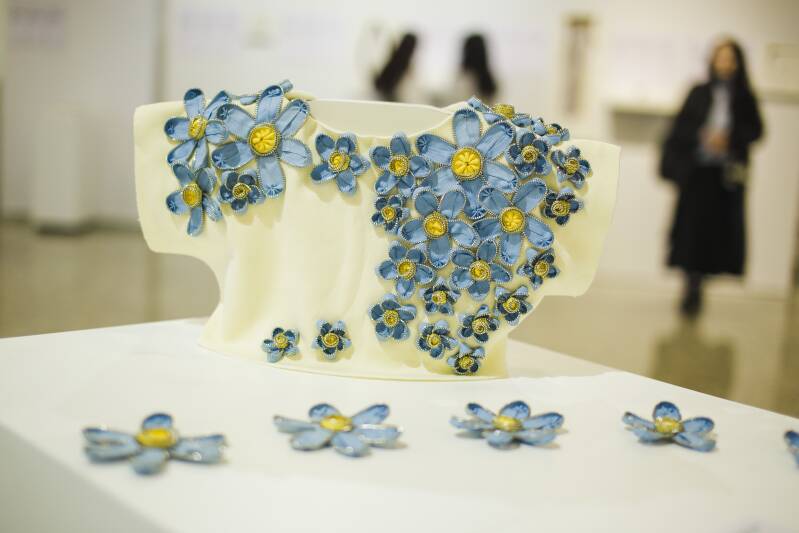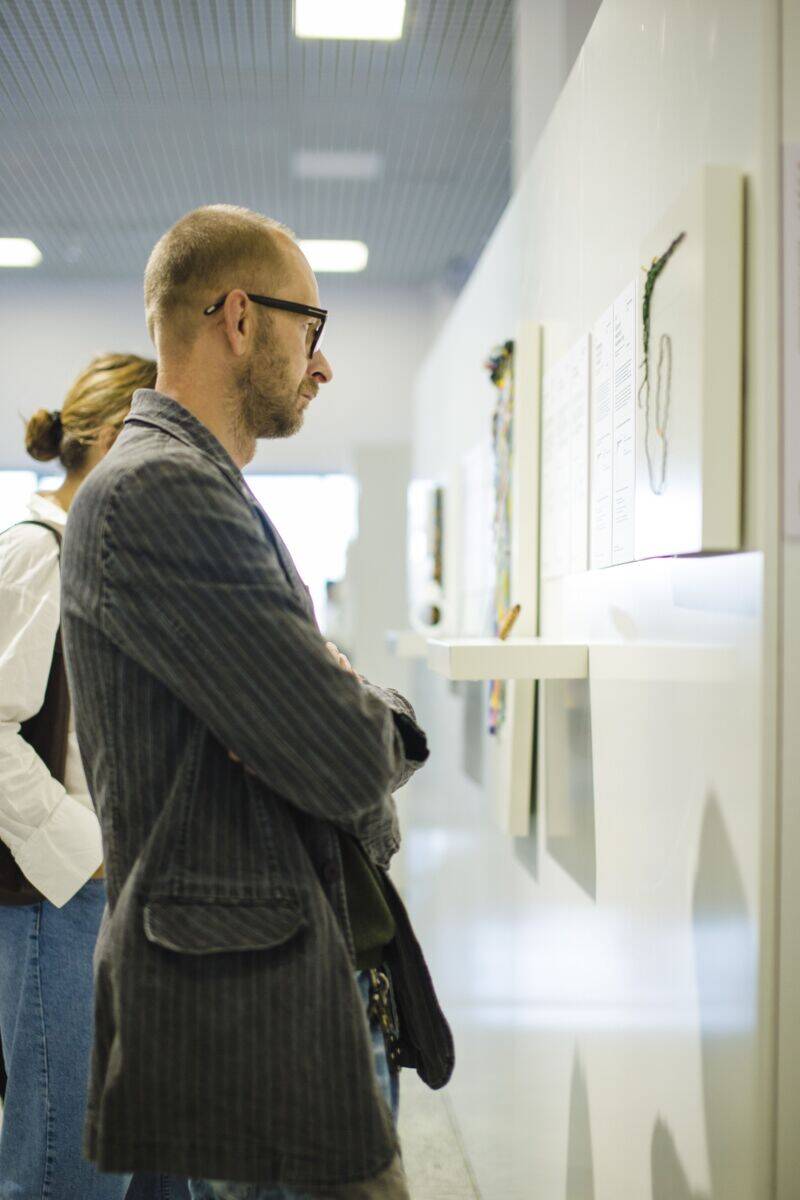This is a copy of the article from https://vlast.kz/life/66938-statistika-kak-ukrasenie.html that has been translated by Google Translate. All rights belong to the original source.

The capital National Museum hosts the first international exhibition of data art and conceptual decorations “Jewelry Code. “The statistics you can wear.” Conceptual jewelry is not just jewelry, but a way to talk about feelings, memory, social, gender, environmental and other topics through form and material.
On the seventh floor of the National Museum, an unusual exhibition is jewelry that you need not just to consider, but understand. In each, a unique idea based on real data. Some are made of recycled materials, others - from the usual, but unexpectedly reinterpreted. Here is every piece of the meaning.
In the center of the hall we are met by Zhanna Asanova - artist, curator and founder of the project Sydyr. It was she who organized the first exhibition of conceptual decorations in Kazakhstan and collected the works of authors from different countries here.


Photo's by Veronica Lerner
We barely start the conversation, and the look already clings to the necklace on it. Zhanna notices my curiosity and explains - this is one of her favorite jewelry from the series Connections ("Teaks"). The prototype was a chaotic web of electrical wires in Pakistani cities, where Zhanna lived for several years. In this disorder, she saw a metaphor for human relations - confusing, tense, multi-layered, but still connecting.
The decoration is made of recycled cotton, which local artisans turn into bright ropes. For Zhanna, this work is personal, almost autobiographical. “Sometimes, to regain energy, you just need to let a new line,” she says, correcting the necklace.
Our tour begins. I am waiting, Zhanna is a confident guide to the world of conceptual decorations. Easily moving between showcases, she stops at every job, talks about details and meanings - it feels how carefully it treats each product.

Photo by Veronica Lerner
The exhibition presents the works of more than 60 artists from 28 countries. My attention is attracted by the work of the German artist Anya Eichler - the necklace "Prevention in a Week". At first, you do not understand what it is made of: transparent acrylic spheres, gently strung on the line, flicker under the light.
This necklace is collected from a week of plastic waste accumulated in the house of the artist. Inside each transparent sphere - lids from yogurts, wrappers, labels. They look like tiny artifacts, like archaeological finds from the recent past.
Turning the garbage into jewelry, Eichler offers a look at our everyday habits and what remains after them. This is a kind of reflection on the rutinium of accumulation and the invisible weight of waste that accompany our lives. The result is both attractive and alarming.

Necklace "Extract in an week", Anya Eichler, Duitsland
Material: acryllic spheres, plastic garbage, silver, steel wire with silver coating
photo by Iris Mambur

Photo by Veronica Lerner
Zhanna says that the idea of the exhibition was born from personal experience.
“It all started last year, when I was involved in a project that was carried out by UN women,” she says. – There were trained by artists to work with gender data through art. I became one of the fifteen participants and first learned about the direction of the data art. This literally captivated me – the realization that dry numbers can be turned into an artistic language through which we can talk about society, emotions, human stories. After that, I wanted to make an exhibition where everything will be built around jewelry with meaning.
She takes a few steps forward and stops at the next showcase. On the stand - light, almost air decoration of palm fiber.
The New Palm Fiber Weaving Revolution by Kai Wang, China/UK
Materials: Palm fiber, crystal, wire.
Photo by Veronica Lerner

The artist created this work, fixing his own movements during the traditional palm weaving. The gyroscopic sensor on the phone recorded the trajectory of its gestures - the rotation of the wrists, the inclination of the palms, the small vibrations of the fingers. Then these data turned into a voluminous pattern – a material reflection of bodily experience.
So the decoration on the body becomes a kind of archive of movements, which stores not only the shape, but also the rhythm, smell, touch. The almost forgotten craft comes back to life here through technology and body, turning into a dialogue between the past and the present.
Zhanna briefly stops himself, as if giving time to see a slight interweaving of fibers, and then adds: “You know, this is the power of modern jewelry.”
It is in jewelry that she sees the special energy of modern art. Jewelry is not just an object, but a personal statement that a person carries on himself, literally next to the body. It becomes a continuation of the gesture, a way to speak without words.
“Someone asks, “What does it have you got?” and the dialogue is already about – about the meanings, about the data, about the topic that it raises.”


Photo's by Veronica Lerner
On the next showcase - a necklace, at first glance simple: transparent beads, neatly built into the ranks, as if a memory of childhood. Light affects them gently, creating a feeling of lightness. But, as in many works of this exhibition, behind this simplicity hides something more.
Before us is the work of Natalia Kiseleva from Russia - "The Glitter of Inequality". These are visualized data on the level of income inequality in the ten most populated countries in Europe from 2006 to 2020.
“Everything is built here on data,” says Zhanna. – Each row symbolizes the country, each column is a specific year. Colors become the language of statistics: red denotes a high level of inequality, blue - low.
According to the same principle, a bracelet has been created, which reflects indicators of income inequality already in Kazakhstan.
So ordinary beads turn into a visual story about gaps and differences, into a “jewelry report” about how opportunities and resources are distributed – only now this can not be read, but literally put on on yourself.

"The Glitter of Inequality", Natalia Kiselyova, Russia
Materials: beads, rubber cord, jewelry shirt
Photo by Veronica Lerner
Zhanna talks about the difficulties in organizing the exhibition: “If I knew in advance what I would have to go through, perhaps I would not even dare. At some point, I was just horrified by the scale – but it was too late to retreat. The team had gathered by then, and it was a real dream team. Only thanks to her did it all.”
To attract participants, Asanov and her colleagues announced an international open call - an invitation for artists from all over the world. The announcement was placed on professional sites, where authors working with modern and jewelry are collected.
“We received about 200 applications,” recalls Zhanna. — Of these, 67 artists were selected. Geography – from Senegal to Australia, from Mexico to the UK.
The organization of delivery turned into a separate adventure. Some work went on for weeks, and one went the wrong way.
“There is work that left the United States three times, – laughs Asanov. – First, for some reason, she was stopped on the border of Kazakhstan, then delivered to Kyrgyzstan! It turned out that the American mail confused the address. The artist and I corresponded for a long time until everything was explained. Unfortunately, such stories happen.”
Despite all the difficulties, the exhibition still gathered together - like a mosaic of many routes and efforts


"KyзҰл", Zhanna Asanova, Kazakhstan
Breast ornament
Materials: metal zippers, textiles
Photos by Veronica Lerner
Dozens of flowers of different sizes bloom at the stand. The metal shimmers in the light of the lamps, as if it were cold gold, and only by looking closely, you understand what this beauty is woven - from the lightning that is usually hidden, and here they become the center of attention.
The artist Asanova, through this work, speaks of gender biases in Kazakhstan. For “KyzҰl” there is statistics: more than 82 thousand women and girls, whose names reflect the desire of parents to have a son. Ulbolsyn - "Let there be a son", Ұltu - "the birth of a boy", ҰЛОzhan - "the soul of a boy." Each name is like a tiny reminder of inequality that begins with birth.
The work also mentions the tradition of the image - the first clothes of the newborn, which was given to a woman without children with the desire to give birth to a boy. Sometimes such shirts gathered a whole lot - a kind of collection of hopes and disappointments.
By translating dry numbers and cultural habits into the language of decoration, Zhanna makes visible what is usually hidden – a stable form of discrimination, living in names and in ceremonies.

Photo by Veronica Lerner
“Decoration in Kazakhstan has always had a sacred meaning. It could be a symbol, a talisman, a sign of luck or a gift on a special occasion - always with a certain meaning. We don’t cancel any of this, says Zhanna. – Just adding a new layer. Now it is important for me to show that we can invest in jewelry not only traditional meanings – through ornaments or patterns – but also fill them with new ones. Not erasing the old, but on the contrary, strengthening it, adding to it.
If we talk about our exhibition, then to these traditional meanings we add statistics - facts that reflect socially important topics. More broadly, we give decorrelations the meaning associated with the events taking place in the world and in Kazakhstan, with what people are concerned about today,” explains Zhanna.


Photos by Veronica Lerner
I want to ask: how do Kazakhstanis react? How clear are the ideas of conceptual and jewelry art, combined with numbers and data?
“You know, Katerina, this is perhaps one of the most interesting observations,” Zhanna smiles. Someone is careful, someone is enthusiastic. Not always clear at once, and this is normal. But it is worth starting to tell, explain how the jewelry encrypted real statistics - and people's eyes light up. They begin to see the meaning in this.
And also, - adds Zhanna Quietly, - for me a separate pleasure to listen to how visitors themselves interpret these works. Sometimes they see in them what the author did not lay. And this is probably the most valuable thing – when art begins to live its life.”
She stops for a moment, watching as a young guy looks at bead bracelets made by Hungarian author Silvi Neth.


Photos by Veronica Lerner
The architecture of the exhibition and the online version was coordinated by the art director from Dubai, turning the project into an international – modern, professional, conceived with the times and with world trends.
The curatorial council here includes three people: Zhanna Asanova, Evgenia Kazakova and Katya Rabey. And the visual part worked on the community of data-art designers - it was they who created an infographic that accompanied the exhibits.


Evgenia Kazakova Katya Rabei
Photos by Veronica Lerner
We're going along the exhibits again. On the stands - rings, brooches, necklaces, similar to small manifestos. Each - a statement, a conversation about modernity through metal, plastic, wood, fabric and even noodles of ramen.
I ask Zhanna how she sees the development of this direction in Kazakhstan.
“We really want to have our own direction, our own school,” she says. – Each country has its own characteristics: somewhere strong technology, somewhere – an idea. I don’t know what path we will choose, but artists already appear that make meaningful, strong works.”
In Kazakhstan, the craft school is traditionally strong: jewelry art here is associated primarily with skill and shape, and not with conceptual meanings. Young authors, Zhanna explains, are still difficult to decide on an experiment - too many practical questions: who will buy, where to put, how to monetize it at all.
“Imagine a necklace of puppet toilets,” she smiles. – The question “who will buy it?” It is the first one.”
This art is not about the market, but about the idea. But the process has already begun: at the exhibition there are Kazakhstani participants - young artists who try to talk about important topics through form and material. Perhaps it is with them that a new wave will begin - when galleries will appear, where such works will not just show, but also collect collectors.

With what, as a curator, Zhanna wants people to leave here? She responds right away, without a pause.
“If we talk about the impressions and emotions that people take away from the exhibition, they are very different. In less than a month, I saw everything: tears, and surprise, and bewilderment, and delight. Some come back for the second time – they say that they could not accommodate everything that felt in one visit. This is probably the most valuable thing – when art does not let go.
And if we talk about material things, then we have an interactive project of the artist Sofia Bruckner. It analyzes statistics with Amazon – explores which phrases are most often emphasized by people in romance novels. Based on these statistics, Sophia chose the seven most popular phrases and created a series of bracelets with these quotes. Each bracelet is its own color, like markers with which people distinguish their favorite lines.
Visitors can get a bracelet in exchange for their love story: write it on the card and drop it in a special box. Sophia collects these stories for the book – and perhaps some of the participants’ stories will get into it. Everything happens anonymously, but there is so much frankness in all this.
Interestingly, most often choose blue bracelets. The phrases associated with this color sound like this: “I hope”, “I believe in the good.” We can say that this is also their own small statistics – a reflection of what people leave the exhibition with. ”


Photos by Ksenia Gorlenko
The exhibition “Jewelry Code. Statistics that can be worn" is open in the National Museum of the Republic of Kazakhstan in Astana until December 2.
